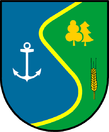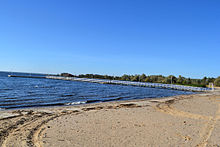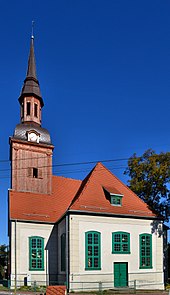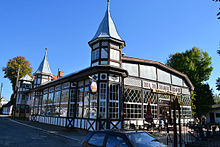Stepnica
| Stepnica | ||
|---|---|---|

|
|
|
| Basic data | ||
| State : | Poland | |
| Voivodeship : | West Pomerania | |
| Powiat : | Goleniów | |
| Geographic location : | 53 ° 39 ' N , 14 ° 37' E | |
| Residents : | 2465 (Jun. 30, 2019) |
|
| Postal code : | 72-112 | |
| Telephone code : | (+48) 91 | |
| License plate : | ZGL | |
| Economy and Transport | ||
| Street : | Goleniów –Stepnica | |
| Next international airport : | Szczecin-Goleniów Airport | |
| Gmina | ||
| Gminatype: | Urban and rural municipality | |
| Gmina structure: | 16 districts | |
| Surface: | 294.16 km² | |
| Residents: | 4887 (Jun. 30, 2019) |
|
| Population density : | 17 inhabitants / km² | |
| Community number ( GUS ): | 3204073 | |
| Administration (as of 2015) | ||
| Community leader : | Andrzej Wyganowski | |
| Address: | ul.Kosciuszki 4 72-112 Stepnica |
|
| Website : | www.stepnica.pl | |
Stepnica (German Stepenitz , also Bad Stepenitz ) is a vacation spot in the Polish West Pomeranian Voivodeship .
Geographical location
The city of Stepnica is located - not far from the German-Polish state border - in Western Pomerania at the point where the water surface of the Oder widens to Roztoka Odrzańska ( Papenwasser ), and south of the Gowienica ( Gubenbach ). The Szczecin Lagoon (Zalew Szczeciński) and the Puszcza Goleniowska ( Gollnower Primeval Forest ) are nearby . The distance to Stettin ( Szczecin ) is 25 kilometers, to Berlin about 150 km.
geology
The landscape was shaped by the Ice Age and shows damp, boggy lowlands and valleys. In the south of the area there are moorland and quarry forest areas, in the east dry valley sand terraces and high forest. The silting process of the oat bank, which goes hand in hand with the formation of bog, is currently still ongoing.
history

The village was founded by German settlers south of the Gowienica ( Gubenbach ) on a valley sand island and originally laid out in the form of a street green village. Groß Stepenitz was first mentioned in 1269 as Stepnitsa . The old place name probably referred to the swampy rivers and streams in the area. Even then, fishing and fish farming was important in Groß Stepenitz because of its proximity to the Stettiner Haff. A port was therefore built, but local wood processing was also an important industry. The village was described as a fishing village as early as the 13th century; gradually it developed into a clustered village .
In 1278 the Szczecin citizen Godekinus de Wretzlavia (Breslau) was enfeoffed by Duke Barnim I with the village of Stepenitz , but as early as 1280 Bogislaw IV compensated him for the village. On July 15, 1281, the nobleman Thamm Flemming was named in a contract document concerning fishing rights . 1302 is Thamm Flemming, Marshal of Pomerania, Mr. zu Stepenitz. On November 19, 1366, his great-grandchildren Tyderich, Tymmo and Henning gave " dat ghut tu der stepenytze " to the Virgin Monastery in Stettin. As early as 1347, Duke Barnim II had announced that he had given the monastery in Stettin " dat Dorp tho der Stepenitz ". In 1374 the donation from 1347 was confirmed by the Camminer Bishop Philipp von Rehberg . In the 14th century, Groß Stepenitz became the property of the Szczecin Cistercians and the chapter of the Szczecin St. Mary's Church.
Opposite Groß Stepenitz, on the other side of the Grubenbach, was the smaller, but probably older Wendish village of Klein Stepenitz . In 1291 the Dukes Bogislaw IV, Barnim II and Otto I transferred two parts of the village of Klein Stepenitz to Johanniter Gerhard von Gollnow . Bogislaw IV confirmed in 1299 the donation of the third part of the village to the Wolin Virgin Monastery by the knight Friedrich von Hindenburg. In 1361 the Order of St. John sold its goods to the Wollin monastery in Klein Stepenitz, so that the whole village came into the possession of the monastery.
The two neighboring villages of Groß Stepenitz and Klein Stepenitz developed separately, since Klein Stepenitz belonged to the monastery in Wollin, while Groß Stepenitz belonged to Stettin. In 1628 there were twenty Hakenhufen , two inns, a blacksmith, shepherds, twelve Inst people and two craftsmen registered for tax purposes in Groß Stepenitz , while in Klein Stepenitz twelve Hakenhufen, five Kossaten, an inn and three Inst people were registered. In 1654, Groß Stepenitz was pledged to the Wollin office.
In 1686 the Amt Stepenitz was formed, the administration of which was under both Klein Stepenitz and Groß Stepenitz, and sold by the Prussian general Karl Friedrich Graf von Schlippenbach to the Elector Friedrich Wilhelm von Brandenburg . In the course of the abolition of the monasteries, Klein Stepenitz later came to the Princely Office of Wollin and Groß Stepenitz to the Princely Office of Old Stettin.
Excise was introduced in Groß Stepenitz in 1721 .
The church, the rectory, the sexton and preacher's widow's house and several other buildings were destroyed by a conflagration on June 1, 1739 in Groß Stepenitz; then the village was rebuilt on a new road network and provided with a wooden church. In 1789, Groß Stepenitz had a total of 126 houses, of which 62 had a tile roof and 64 a thatched roof . During a conflagration on March 21, 1794 , eleven residential houses and various farm buildings were destroyed. In the 18th century there were twenty farms in Groß Stepenitz. Later, the courtyard of the Freischulzen and five desolate farms were turned into a farm, one desolate courtyard was given to the pastor and another desolate courtyard to the head forester, so that in the end only twelve farms were left.
In addition to agriculture and forestry, important occupations of the Stepenitz population were fishing and shipbuilding. Since the Seven Years' War , two to three large seagoing vessels have been built in Groß Stepenitz every year. The old boat yard on the Gowienica ( Gubenbach ) existed until after the First World War . Until then, mostly Haff barges were built: about 40 meters long, wooden vehicles with a flat floor, with or without a hood. The larger barges had three masts, the smaller ones only one. They were designed to travel down the Oder from Stettin to Cammin i. Pom. , Swinemünde and through the Peene even to Stralsund and into the Barther and Saaler Bodden and back again. These ships were after World War of so-called barges displaces: non-driven boats made of iron, of tractors are drawn.
Ship's captain Radmann, who came from the Stepenitz seafaring family Radmann, another captain and a timber merchant founded the Stepenitz shipping company , an open trading company , in Groß Stepenitz with a steamer bought in England . In 1860 two merchant ships operated from Stepenitz, in 1863 already four. In 1900 the shipping company was converted into a limited liability company and entered in the commercial register in Stepenitz under the name Stepenitzer Dampfhandelsgesellschft GmbH .
Stepenitz had two fishing ports, one at the Seglerhafen , the other south of the railway port . In 1929, 55 full-time fishermen were counted in Stepenitz. Before 1945 there were about 30 fishing families with 55 to 60 fishermen.
A considerable economic upswing set in after the creation of a bathing beach by washing up white sand on the Stepenitz meadows, which had been dredged from the Papenwasser channel in 1910 on the occasion of the deepening and straightening of the Stettin - Swinoujscie shipping route. Between the boat harbor, which was protected by a twenty-meter-long concrete pier, and the Stepenitz Canal, a narrow but attractive beach was initially created. The concrete pier also provided protection for the newly built marina. After the First World War , the beach was further washed up and enlarged by about ten times. This led to a rush of bathers from May to September, especially from Szczecin. Gastronomic facilities were expanded or refurbished, beach chairs were rented and a large lake terrace was built in front of one of the restaurants. The Stepenitz Steamship Company acquired the Bad Stepenitz passenger steamer in 1927 for 189,000 Reichsmarks . In order to be able to raise the capital required for the purchase, the Dampfschiffahrtsgesellschaft was converted into a stock corporation with 250 registered shares worth 100,000 Reichsmarks each. In 1942 the steam shipping company was converted back into a GmbH.
In the interwar period , Groß Stepenitz was a popular local recreation area for residents of nearby Szczecin thanks to its wooden pier with a café, its large beach and a marina . Guests were in the tourist resort 6,000 beds available, and to the gripping Kleinbahn belonging narrow gauge railway connected the town with Greifenberg and Gülzow .
In 1928 there were 52 professional fishermen from the lagoon and river fisheries in Groß Stepenitz.

In 1936 the district of Stepenitz (after the amalgamation of Groß Stepenitz with the villages of Groß Stepenitz and Klein Stepenitz to form the municipality of Stepenitz, see below: Incorporations ) had an area of 21.7 km².
Until 1945 Stepenitz belonged to the district of Cammin i. Pom. in the administrative district of Stettin of Pomerania . Stepenitz was the seat of a local court to which the villages of Schminz, Rissnow, Pribbernow, Hammer and Amalienhof were also subordinate.
Towards the end of the Second World War , on March 4 and 5, 1945, the Red Army , coming from the south-east, quickly advanced to the Stettiner Haff , Dievenow and Oder , but came to a standstill there for nine weeks. During this time, the Soviet army from the island of Wollin and the Baltic Sea was under constant German artillery fire. Stepenitz and other localities (including Dievenow , Cammin, Köpitz, Hagen, Laatzig, Fritzow, Düssin, Gaulitz , Grabow and Langenberg) were almost completely destroyed. After the bridges had been blown up on March 5th and 6th, many Stepenitzers took the steamboat across the lagoon. After the German surrender in May 1945, the crossings over Oder, Haff and Dievenow were closed to Germans by the Poles, so that in some cases refugees could not return to their hometowns.
Soon after the end of the war, the region was placed under Polish administration together with the whole of Western Pomerania, Stettin and part of Western Pomerania . The immigration of Polish civilians began. Stepenitz was renamed Stepnica by the Poles . The remaining German population, with the exception of a few people, was driven westward by the Poles from the summer of 1945 . The evictions were carried out at short notice and only hand luggage was allowed, which was very often plundered during the march to the Oder and when crossing the Haff, Dievenow and Oder. The expulsion of the German population was largely complete in the same year. Today the village has about 5000 inhabitants. City charter was given on January 1st, 2014.
Development of the population
- 1782: 643, in Groß Stepenitz
- 1864: 1758, in Groß Stepenitz
- 1868: 1644, in Groß Stepenitz
- 1925: 1617, in Groß Stepenitz
- 1932: 1617, in Groß Stepenitz, including four Catholics
- 1936: 2866, in Stepenitz, after the merger of Groß Stepenitz, Flecken with Groß Stepenitz, Dorf and Klein Stepenitz on April 1, 1936
- 2011: 4902
Incorporations
In terms of administrative policy, the three independent municipalities existed until March 31, 1936:
- Groß Stepenitz, spots with (1932) 1,617 inhabitants, including four Catholic, and an area of 2.7 km² in the district
- Groß Stepenitz, village with (1932) 390 inhabitants, including two Catholic, and an area of 10.5 km²
- Klein Stepenitz with (1932) 677 inhabitants, including one Catholic, and an area of 8.5 km² in the district
Around 1930, the Groß Stepenitz area housed six residential spaces:
- Stepenitz depository
- Forest secretary farm Stepenitz
- Groß Stepenitz, Flecken
- Stepenitz small station
- Mill
- Stepenitz Forestry Farm
Around 1930 there were eleven places to live in the village of Groß Stepenitz:
- Birch forest
- Buwin
- Chausseehaus
- Ferdinandshof
- Forsthaus Schöneich
- Forest house Stepenitz
- Groß Stepenitz, village
- Marienhof
- Red sand
- Schiekenhorst
- Four
The village of Klein Stepenitz had three places to live around 1930:
- Little Stepenitz
- Sandhof
- Four houses
In the three localities together, 2,667 Protestant and 7 Catholic inhabitants were counted in 1932, a total of 2684. The three localities, like the villages of Flacke and Schützendorf, belonged to the Stepenitz district.
Shortly before the Second World War, the merger of the area Groß Stepenitz with the village Groß Stepenitz and the village Klein Stepenitz was implemented against considerable resistance from the local community and estate representatives and took effect on April 1, 1936. The municipality Stepenitz emerged from the merger with an area of 21.7 km² and 2866 inhabitants.
Attractions
- The classical parish church of St. Hyacinth; a plastered half-timbered building from 1741
- Half-timbered and brick houses from the 19th / 20th centuries century
Personalities
Sons and daughters of the place
- Wilhelm Wider (1818–1884), German painter, President of the German Art Association in Rome
- Robert Parlow (1835–1901), German marine painter
- Robert Hilgendorf (1852–1937), German captain, ran cargo sailors for the Hamburg shipping company Laeisz
- Daniel Gerth (1891–1934), German officer in World War I, was executed in 1934 as an SA leader by the SS
- Arnold Klünder (1909–1976), German painter, graphic artist and ceramist, worked in Ahrenshoop
- Dieter Blumenberg (1925–2019), German politician (SPD) and member of the state parliament
- Manfred Schatz (1925–2004), German impressionist painter
Connected to the place
The sailor Robert Hilgendorf lived in the village for a while.
local community
The rural community Stepnica covers an area of about 300 km² and consists of the main town of the same name and the following 15 districts:
|
The municipality has been a popular tourist destination, especially since the fall of the Wall. In addition to Stepnica, important vacation spots in the municipality are Jarszewko ( Jassow am Haff ), Żarnowo ( Altsarnow ) and Łąka ( Lanke ).
Prehistoric finds
In the past, a number of prehistoric artefacts were recovered in the district of Stepenitz, which point to long-ago human activities in the region, including
- a deer horn ax and a piece of antler from the giant deer that was worked without stone tools
- a: from the New Stone Age (. 4th century BC.) Feuersteinbeil , a hole hammer, a hole ax and a large plow wedge from schistose rock
- from the Bronze Age (2nd millennium v. Chr.): a fluting -Steinscheibe with peripheral groove and - on the Galberg - an urn field with urns of clay
- from the pre-Roman Iron Age : a fire urn from the La Tène period
The finds do not allow any conclusions to be drawn about the younger Iron Age ( Wende and Viking Age ). Most of the finds were exhibited in Szczecin and Berlin museums.
literature
- The district of Cammin - A Pomeranian homeland book. (compiled and developed by Hasso von Fleming-Benz), Holzner, Würzburg 1970, in particular pp. 98–117: The community of Stepenitz.
- Heinrich Berghaus : Land book of the Duchy of Pomerania and the Principality of Rügen. Part II, Volume 6, Anklam 1870, pp. 331-337 ( online ).
- Ludwig Wilhelm Brüggemann : Detailed description of the current state of the Royal Prussian Duchy of Western and Western Pomerania. Part II, Volume 1: Description of the districts belonging to the judicial district of the Royal State Colleges in Stettin. Stettin 1784, pp. 12-15 ( online ).
Web links
See also
Individual evidence
- ↑ a b population. Size and Structure by Territorial Division. As of June 30, 2019. Główny Urząd Statystyczny (GUS) (PDF files; 0.99 MiB), accessed December 24, 2019 .
- ^ Website of the municipality (BIP), Dane teleadresowe , accessed on March 11, 2015
- ^ Georg Wilhelm von Raumer : The island of Wollin and the seaside resort of Misdroy. Historical sketch . Berlin 1851, p. 52.
- ↑ Ludwig Wilhelm Brüggemann : Detailed description of the current state of the Royal Prussian Duchy of Western and Western Pomerania . Part II, Volume 1: Description of the districts belonging to the judicial district of the Royal State Colleges in Stettin . Stettin 1784, pp. 17-26 .
- ^ Heinrich Berghaus : Land book of the Duchy of Pomerania and the Principality of Rügen . Part II, Volume 6, Anklam 1870, pp. 322-349 .
- ^ A b c d Christian Friedrich Wutstrack : Addendum to the brief historical, geographical, statistical description of the royal Prussian duchy of Western and Western Pomerania . Stettin 1795, p. 148.
- ↑ Christian Friedrich Wutstrack : Short historical, geographical, statistical description of the royal Prussian duchy of Western and Western Pomerania . Stettin 1793, p. 433.
- ↑ Brüggemann (1784), pp. 12-15 .
- ^ Yearbook for the official statistics of the Prussian state. 1st year, Berlin 1863, p. 558 .
- ↑ Flemming-Benz (1970), p. 108 ff.
- ↑ Flemming-Benz (1970), p. 465.
- ↑ Flemming-Benz (1970), p. 533.
- ↑ Flemming-Benz (1970), p. 535.
- ↑ Flemming-Benz (1970), p. 541: The expulsion of the German population .
- ^ [1] Dziennik Ustaw
- ↑ Christian Friedrich Wutstrack : Addendum to the short historical-geographical-statistical description of the royal-Prussian duchy of Western and Western Pomerania . Stettin 1795, p. 148.
- ↑ a b Berghaus (1870), p. 331.
- ↑ a b Guthard Stübs and Pomeranian Research Association: The Stepenitz community, Flecken in the former Cammin district in Pomerania (2011).
- ↑ Flemming-Benz (1970), p. 110.
- ↑ population. Size and Structure by Territorial Division. As of December 31, 2011 Bilans opracowany na bazie wyników NSP'2011 (Excel table) ( Memento of the original from August 17, 2012 in the Internet Archive ) Info: The archive link was inserted automatically and has not yet been checked. Please check the original and archive link according to the instructions and then remove this notice. . Główny Urząd Statystyczny (GUS), accessed December 11, 2012.
- ↑ Gunthard Stübs and Pomeranian Research Association: The community of Groß Stepenitz, Dorf, in the former district of Cammin in Pomerania (2011.)
- ↑ Gunthard Stübs and Pommersche Forschungsgemeinschaft: The community of Klein Stepenitz in the former district of Cammin in Pomerania (2011).
- ↑ Flemming-Benz (1970), pp. 98-99.





